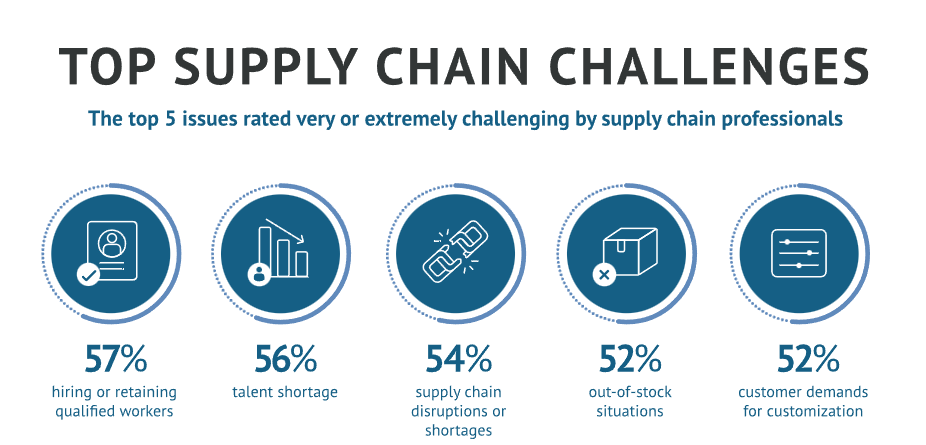A smooth and unforgettable buying experience is what all consumers are looking forward to when purchasing online. Data-driven supply chain management (SCM) acts as a conductor in a symphony to ensure information and services complement each other to their “eventual crescendo”—— a successful delivery. In the interconnected world of intricate supply networks, the continuous heartbeat of modern eCommerce relies on SCM, for it manages the flow of goods efficiently.
The wonder of supply chain technology isn’t just about tracking. It’s about seamlessly connecting every process stage, from manufacture to your customer’s doorstep. While wholly necessary, data isn’t the end-all catalyst for success. It’s an integral piece of the larger supply chain machine. Solid and enduring partnerships with vendors and suppliers utilize cutting-edge technology, making every detail accurate and complete. Cost control can be quickly done on the back end, keeping your overhead expenses low. Searching for the right logistical partners is a rewarding quest that leads to operational efficiency and excellence. Supply chain management is not just a process. It’s a story where people, innovation, and relationships come together for eCommerce and cooperation.
- Understanding the Importance of Supply Chain Technology
- Three Supply Chain Technology Trends for Online Merchants
By 2025, Gartner predicts that more than 50% of logistics organizations will have experienced a technology takeover of their business. This tech upgrade is crucial to building supply chain resilience. This resilience refers to a supply chain’s ability to endure, adjust, and recover from disruptions. It involves techniques, procedures, and technological advancements that allow supply chains to operate efficiently in the face of disaster.
Having cutting-edge tech solutions is vital to combating stagflation. And what is stagflation? It is an economic cycle marked by inflation, high unemployment, and poor expansion. This confluence is particularly challenging to manage because addressing one issue can worsen another.
2023 Supply Chain Statistics: Industry Trends & Turbulence (fitsmallbusiness.com)
Technology keeps every link in the supply chain strong. It allows for faster responses to any factors contributing to stagflation.
Understanding the Importance of Supply Chain Technology
The digital tools that support the organization and effectiveness of the supply chain are known as supply chain technology. By utilizing power technology, supply chain links can collect massive amounts of data and use it to enhance operations. It can also help implement new procedures, increase efficiency, or formulate plans.
The eCommerce industry now uses many supply chain technologies with different levels of sophistication and influence. In their most basic forms, supply chain technologies enable users to input data or convey critical signals instantly. More advanced technology uses artificial intelligence (AI) and robotics, undoubtedly popular options today. However, note that most supply chain technology is essential to online businesses and shouldn’t be taken for granted.
Effective supply chain managers and stakeholders constantly look for methods to streamline and improve their supply chains. These are important since the faster goods can be produced, processed, and delivered, the more satisfied the customers are. Improved customer satisfaction means more transactions and more money.
Supply chain managers should, therefore, be actively involved with their technology and look for ways to streamline and enhance it.
-
Comprehensive Operations Insight
Reviewing data and getting essential insights on customer demand, storage/transportation constraints, and supplier lead times are complex. Insight is the cornerstone of crucial decision-making. It makes the business processes above simpler.
You can make more informed decisions that directly and indirectly affect the supply chain’s functioning.
Supply chain technology has characteristics that promote faster and better decision-making. This enables your business to process data and run simulations in real-time based on numerous circumstances, letting you weigh potential solutions. Better decisions can be made by comprehending the tradeoffs involved with each scenario response.
-
Greater Access to Information
Effective supply chain technology links previously isolated data. You have an information silo when different parts of your supply chain. These are people, computer systems, or outside trading partners that don’t communicate information regularly. Silos can develop when internal corporate divisions and operations (such as sales, production, and distribution) do not share information. It can lead to longer reaction times, faulty execution, and incorrect forecasts.
Supply chain technology captures data and makes it accessible to all shareholders. The concept of “visibility” makes sense when you can perceive your entire environment from all angles. Visibility includes internal insights extending over to supply chain partners. You’ll also want an in-depth look into customer behavior. That includes network-wide information on significant supply chain operations, demands, and disruptions. With the advancements in mobile technology, online businesses can now check inventory status, warehouse activity, and product movement at any time and anywhere. These capabilities allow for immediate customer service.
Companies with superior supply chains can see orders, inventory, workforces, transportation networks, warehouses, and partner activity. They put that information to use by anticipating events more clearly, making better plans, and responding immediately. Your business can react quickly to unplanned, possibly disruptive events with solid supply chain information.
-
Business Agility
Agility is improved with supply chain technology. With instant access to information and simulations, online merchants can solve issues or develop new business opportunities faster.
You won’t be able to operate quickly if your organization, processes, or systems contain barriers or silos. You must monitor occurrences throughout the supply chain, assess their effects, and develop preventative measures.
Suitable supply chain technologies will most likely suggest the “best” actions, which you can apply as soon as they become available. This capability is essential in the fast-paced business environment of today. It ensures everyone in the organization is informed of new decisions, and tech solutions make that possible.
-
Clear Collaboration
Collaboration is when two or more people or organizations cooperate to achieve a common objective. Successful supply chains sustain a constant flow of information, analysis, and decisions. This is achieved through systems and technology that enable, monitor, and assess collaboration across individuals, departments, and organizations.
Collaboration is essential as omnichannel consumers demand more choices, speed, and flexibility. Only digitally optimized businesses can provide the agility and reactivity necessary to meet these expectations successfully. One defining feature of supply chains in highly competitive industries is the capacity to maintain synchronization across a wide network.
Manufacturers and retailers who have mastered this level of cooperation consistently perform better, such as higher inventory turns, cost savings, and service levels.
When everyone shares useful information, it helps fuel better communication and collaboration.
-
A Consistently Excellent Customer Experience
Due to the difficulties the omnichannel consumer faces, supply chain technology is more critical than ever for retaining and gaining new customers. Before visiting the store and purchasing, customers want to ensure that the items they want are available.
Retailers require on-time and complete shipments to ensure products are in their locations when customers make in-person purchases or place online orders. When you avoid stockouts and delayed deliveries, customer loyalty and experience are improved. This is much harder to achieve without the visibility, accuracy, and agility of supply chain technology.
Three Supply Chain Technology Trends for Online Merchants
Thanks to its quick improvements and creative solutions, technology has become a potent aid in constructing reliable and flexible supply chains. By utilizing technology, businesses can reduce risks and improve operational effectiveness, agility, and customer happiness.
1. Cloud Technology
The significant advantage of cloud computing and cloud-based eCommerce networks is that they allow businesses to access enormous IT resource pools. The best part is that online merchants don’t need to construct and maintain a data center infrastructure, which is quite expensive. Instead of spending on extra servers and storage space, businesses can use the cloud to deploy resources as needed.

Cloud Computing in E-commerce – A Promising Future or Hype? – Apptunix Blog
Thanks to cloud technologies, organizations can consolidate all logistics and supply chain data into a single, centralized solution. Instead of using point-to-point data transmission, centralized information removes data silos and improves information exchange. Partners, suppliers, and end users can access pertinent, accurate, and up-to-date information.
2. Blockchain
The potential of blockchain technology to change supply chain operations has attracted much attention. Businesses using distributed ledger technology can generate a visible and unchangeable record of every transaction. These unique features assist in guaranteeing accountability and traceability.
For example, the food and pharmaceutical industries place a premium on product authenticity, provenance, and compliance. Blockchain makes it easier for supply chain partners to collaborate and share data securely, lowering the risk of fraud, forgery, and unauthorized access.
3. Warehouse Robotics
Robotics have been used in manufacturing for quite some time now, but they are becoming increasingly prevalent in the supply chain for eCommerce.
Robots were once exclusively used for industrial manufacturing jobs since they threatened human safety. However, this is no longer the case, as large supply chains now use robotics to expedite and enhance accuracy in retail fulfillment.
Order picking can make up to 55% of your warehouse labor expenditures. This leaves less time for warehouse workers to concentrate on process improvements and new process implementation.
Robotics can automate labor-intensive fulfillment tasks, such as walking from one side of a fulfillment center to another. By letting robots do the tedious tasks, the human workforce can focus on more high-value tasks like workflows and develop more sustainable packaging.
Due to the complexity of supply networks and how intertwined the global market is, it can get fragile when unforeseen occurrences occur. Investments in logistics and innovation can improve business readiness and provide the products that customers want and need, especially during emergencies.
Aratum specializes in consolidating your software ecosystem with supply chain technology. Optimize every step in your supply chain and see an immediate impact on your operations. Request a demo today to find out how.
*Stock image was sourced from Unsplash




